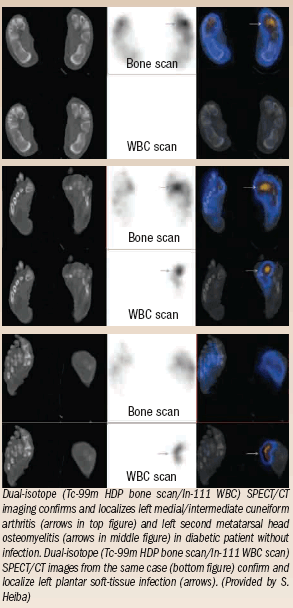Dual-isotope SPECT/CT finds infections in diabetic feet
Nuclear medicine physicians at Mount Sinai Medical Center in New York City have reported encouraging results with dual-isotope SPECT/CT for accurately diagnosing and localizing infection in the feet of diabetic patients.
Nuclear medicine physicians at Mount Sinai Medical Center in New York City have reported encouraging results with dual-isotope SPECT/CT for accurately diagnosing and localizing infection in the feet of diabetic patients.
Correctly differentiating between osteomyelitis and softtissue infection has important implications for the choice of treatment for such patients, especially the 70,000 who annually lose a limb to diabetes- related amputation. A better diagnosis could cut the amputation rate and reduce the extent of disability associated with imprecise excision, said principal investigator Dr. Sherif Heiba, an associate professor of radiology at Mount Sinai.
The Mount Sinai group has accumulated more than two years of experience with a nuclear imaging protocol that zeros in on the precise nature of disease for diabetes patients with suspected foot infections. The patient arrives on the first day to have blood drawn for white blood cell labeling with indium-111. A routine threephase planar bone scan, including blood flow and blood pool imaging of the affected foot, is then performed with technetium- 99m hydroxymethylene diphosphonate (HDP) or methylene diphosphonate (MDP).
Subsequently, patients are injected with In-111-labeled white blood cells (WBC) as preparation for imaging to be performed the following day.
The second-day workup begins with simultaneous planar Tc- 99m HDP bone and In-111 WBC scans. This scan is negative, indicating an absence of infection, for about 10% of patients. These patients are discharged without additional imaging.

Patients with positive scans move on to the heart of the imaging series, according to Heiba. They receive a dual-energy Tc-99m HDP bone/In-111 WBC SPECT/CT scan. Its key advantage is an ability to eliminate the misregistration that frequently occurs when the two scans are performed separately. In addition, the CT portion of the exam provides anatomic landmarks for the physiologic images.
The location of a foot infection can profoundly affect the management of diabetic patients. Surgical debridement and systemic antibiotic treatment is often the treatment of choice for osteomyelitis afflicting these patients. Soft-tissue infection may be addressed with antibiotics alone.
"Even an inch difference in the location of the infection makes a difference," Heiba said. "If amputation is required, the surgeon can be much more certain about excising only the involved bone and tissue by having access to these SPECT/ CT scans."
Dual-energy Tc-99m HDP/ In-111 WBC SPECT/CT (called step 1 by the protocol designers) is powerful enough to secure an accurate assessment for about 80% of patients without more imaging, Heiba said. The other 20% exhibit uptake patterns, particularly in the midfoot, that suggest the presence of a Charcot arthropathy, a form of multiple bone trauma and arthritis that can be confused with infection.
This group requires a third day of nuclear imaging, according to Heiba. Dual-energy imaging in this instance involves Tc-99m sulfur colloid bone marrow imaging/In-111 WBC SPECT/CT (step 2). A finding of osteomyelitis in Charcot joint is confirmed when Tc-99m sulfur colloid uptake is absent or much less than the uptake of In-111-labeled white blood cells.
"This has been an extremely valuable test for us," Heiba said.
Meta-Analysis Shows Merits of AI with CTA Detection of Coronary Artery Stenosis and Calcified Plaque
April 16th 2025Artificial intelligence demonstrated higher AUC, sensitivity, and specificity than radiologists for detecting coronary artery stenosis > 50 percent on computed tomography angiography (CTA), according to a new 17-study meta-analysis.
The Reading Room: Racial and Ethnic Minorities, Cancer Screenings, and COVID-19
November 3rd 2020In this podcast episode, Dr. Shalom Kalnicki, from Montefiore and Albert Einstein College of Medicine, discusses the disparities minority patients face with cancer screenings and what can be done to increase access during the pandemic.
Could Lymph Node Distribution Patterns on CT Improve Staging for Colon Cancer?
April 11th 2025For patients with microsatellite instability-high colon cancer, distribution-based clinical lymph node staging (dCN) with computed tomography (CT) offered nearly double the accuracy rate of clinical lymph node staging in a recent study.